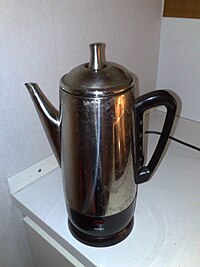Coffee percolator

A coffee percolator (caffettiera in Italian) it is a type of pot used to brew coffee. The name stems from the word "percolate" which means to cause (a solvent) to pass through a permeable substance especially for extracting a soluble constituent [1]. In the case of coffee-brewing the solvent is water, the solute is coffee grounds and the soluble constituent is, of course, the liquid coffee which we drink. There are two basic types of percolator:
- One which forces boiling water under pressure through the grounds into a separate chamber; and
- One which continually cycles the boiling brew through the grounds using gravity until the required strength is reached[2].
Coffee percolators once enjoyed great popularity but were supplanted in the early 1970s by automatic drip coffee makers, and more recently by the French press, as well as a renewed interest in espresso coffee. Percolators often expose the grounds to higher temperatures than other brewing methods, and may recirculate already brewed coffee through the beans. As a result, coffee brewed with a percolator is susceptible to over-extraction[3]. In addition, percolation may remove some of the volatile compounds in the beans. This results in a pleasant aroma during brewing, but a less flavourful cup[4]. However, percolator enthusiasts praise the percolator's hotter, more 'robust' coffee, and maintain that the potential pitfalls of this brewing method can be eliminated by careful control of the brewing process[5].
Brewing process

A non-pressure driven percolator consists of a pot with a small chamber at the bottom which is placed closest to the heat source. A vertical tube leads from this chamber to the top of the percolator. Just below the upper end of this tube is a perforated chamber.
The desired quantity of water is poured into the water chamber of the pot and the desired amount of a fairly coarse-ground coffee is placed in the top chamber. It is important that the water level be below the bottom of the coffee chamber.
After the percolator is placed on the heat source (such as a range or stove), the temperature rises until the water in the bottom chamber boils. While some models may have a one-way valve at the bottom of the tube which forces some of the boiling water up the tube, most operate on the simple principle that the rising bubbles will force the liquid up the tube. The hot water is distributed at the top over the perforated lid of the coffee chamber. This water then seeps through the coffee grounds and leaves the coffee chamber through the bottom, dropping back into the lower half of the pot. The rest of the colder water at the bottom is meanwhile also forced up the tube, causing this whole cycle to repeat continually.
As the brew continually seeps through the grounds, the overall temperature of the liquid approaches boiling point, at which stage the "perking" action (the characteristic spurting sound the pot makes) stops, and the coffee is ready for drinking. In a manual percolator it is important to remove or reduce the heat at this point (keeping in mind the adage "Coffee boiled is coffee spoiled"). Brewed coffee left on high heat for too long will acquire a bitter taste.
Some coffee percolators have an integral electric heating element, and should obviously never be used on a stove. Most of these automatically reduce the heat at the end of the brewing phase, keeping the coffee at drinking temperature but not boiling.
Usage
Percolators are often popular among campers and other outdoorsmen due to the ability to make coffee without electricity. Non-pressure percolators may also be used with paper filters.
Naming convention
There exists some controversy as to whether the Moka Pot may be referred to as a percolator. If common usage defines the word then it certainly must be accepted as a common name. Scientifically the term is also correct, with the problem boiling down to the question of "Can pressurised hot water be percolated through a medium?" If the answer is yes then the form of brewing which takes place in the Moka Pot (the forcing of steam through coffee grounds) can be considered a type of pressure-driven percolation and, therefore, the machine which causes it to happen can be termed a "percolator". So, strictly speaking, because the Moka Pot has a percolating compartment it can be referred to - mechanically - as a (machine which) percolates. This forcible driving of hot water through a coffee layer has been referred to as "percolation" in patents[6]. The Moka Pot is described by Saveur as a juxtaposition of percolated coffee and espresso[7], which acknowledges that percolation is part of the espresso-making process in the Moka Pot. Whilst the Specialty Coffee Association of America[8] recognises six basic methods of brewing (Steeping, Decoction, Percolation, Drip Filtration, Vacuum Filtration and Pressurised Infusion) the differentiation of "Percolation" and "Pressuried Infusion" does not negate the fact that percolation occurs in the Moka Pot (ie: water is filtered through coffee grounds).
References
- ^ "percolate". Merriam Webster. 2008. Retrieved 2008-01-09.
- ^ "About Coffee: Coffee percolator". Ara Azzurro. 2007. Retrieved 2008-01-09.
- ^ S. E. Smith (2008). "What is a Coffee Percolator?". wiseGEEK. Retrieved 2008-10-20.
- ^ "Coffee Drinks". Fulcrum Health Ltd. Retrieved 2008-10-20.
- ^ "How to Make Coffee in a Percolator". Talk About Coffee. Retrieved 2008-10-20.
- ^ Novi, Andrea Ivo and Prato, Modesto (1963). "Machine for Preparing Coffee Infusion". United States Patent Office. Retrieved 2008-01-09.
{{cite web}}: CS1 maint: multiple names: authors list (link) - ^ Turer, Spencer (2008). "How Do You Brew?". Saveur. Retrieved 2008-01-09.
- ^ "Brewing". Specialty Coffee Association of America. unknown. Retrieved 2008-01-09.
{{cite web}}: Check date values in:|year=(help)CS1 maint: year (link)
